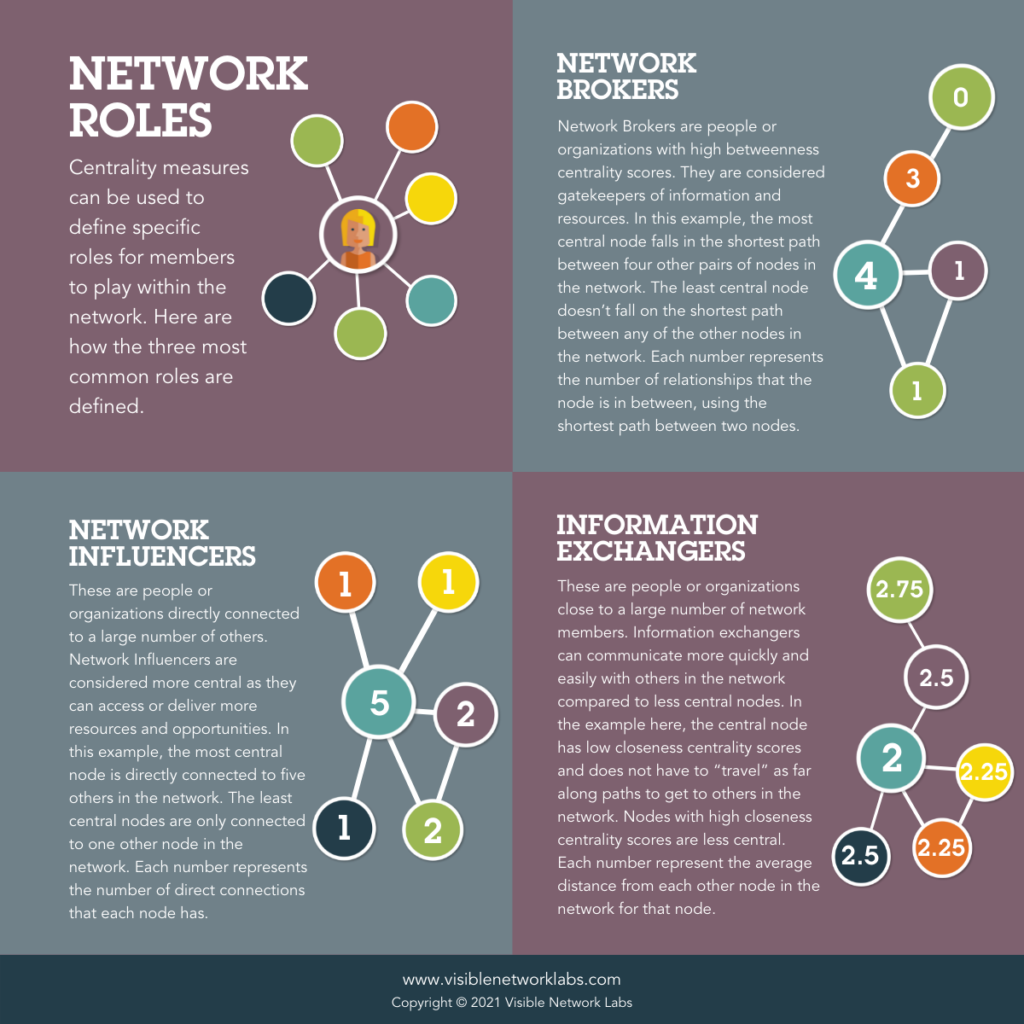
Using Network Centrality to Identify Key Players in Your Network
Network centrality measures the degree to which a node is ‘central’ in a network. This makes it a great tool for identifying the key players in your network. These are typically the community partners most centrally connected within your network, as they access more information and have more influence than their peers. There are three types of centrality, each identifying a different type of key player – including network influencers, brokers, and information exchangers. In this article, we share what each of these key players does and how you can identify them, using the three types of network centrality.
The Three Types of Network Centrality
The first type of centrality is degree centrality, which measures the number of direct connections each network member has. For example, if you partner with more organizations than any other network member, you would have the highest degree centrality measurement.
The second type of centrality is betweenness centrality, which measures the number of shortest paths that a network member lies on. By path, we refer to the chain of individuals you must communicate through to contact someone you are only indirectly connected to. Betweenness centrality is often used to measure information flows within the network since network members on shorter paths will receive more information than others on more extended, less frequently used paths.
The third type of network centrality is closeness centrality, which measures how close a network member is, on average, to all other members. For example, an individual with few direct connections, but many indirect connections, would be less close to the group overall than someone directly connected to most of the network. Close network members can disseminate information broadly across the network quickly.

Using Degree Centrality to Identify Network Influencers
Degree centrality is the easiest metric to calculate. Simply count the number of connections each node has to have a primary measure of degree centrality. Those with the most connections are natural influencers in the network. They can reach the most people directly to share information and opportunities, leverage resources, or influence the rest of the network. These network members are natural leaders, given they are better known than others. Once you identify them, you may consider inviting them to fill leadership roles.
Using Betweenness Centrality to Identify Network Brokers
Betweenness centrality is more challenging to calculate. It requires you to identify the shortest path between each pair of nodes and then figure out how many times each node lies on the shortest path. Tools like our PARTNER CPRM platform can calculate and provide these metrics automatically. Network members with high betweenness centrality are often gatekeepers in the network, regulating the flow of information and opportunities throughout the network. Building strong relationships with Network Brokers helps ensure they share information more effectively when necessary and helps share opportunities and resources back to the center of the network.
Using Closeness Centrality to Identify Information Exchangers
Closeness centrality is another complex measure to calculate. You must measure the paths between every pair of nodes in the entire network to figure out how far each node is from the others on average. Once again, you can do this quickly and easily with a tool like our PARTNER Community Partner Relationship Management (CPRM) software.
Network members with high closeness centrality can rapidly exchange information, making them good partners to activate when promoting a new idea or program and disseminating resources or data among sub-groups or cliques within the more extensive network.
Leveraging Key Players to Achieve Shared Goals
Identifying key players is the first step in strategically managing your network’s members and roles. With a list of your network’s key players, including influencers, brokers, and information exchangers, you should return to your network’s overall goals and the barriers you face.
If you need to build up your leadership team and provide more legitimacy for the network, consider leveraging your network influencers. If your network struggles with information bottlenecks, you should work with your network brokers to ensure information flows more naturally. Building relationships with more information exchangers will help you reach your goals if you focus on active dissemination.
More Resources About Network Centrality and Identifying Key Players
Looking for more information about network centrality and key players in a network? Here are a few more articles, infographics, and resources to help you.

About the Author: Alex Derr, M.P.A.
Director of Marketing & Communications
Alex joined VNL in 2017, originally supporting our events. He now helps manages our communications and marketing strategy and content development work. Alex creates blogs, infographics, reports, and other content while managing our web and social media presence. He also runs our email marketing campaigns, tracks analytics, and conducts market research to drive our strategy. He supports our entire team with copywriting, graphic design and research, and helps with events, webinars, demos, and other online learning. When he isn’t at work Alex spends his time climbing 14ers (30 done, 28 to go!) and blogging on his own website, The Next Summit Blog.




